What is the Difference Between Graphite and Charcoal?
Graphite and Charcoal are a common feature of many artists’ sketching sets. Whether you use sticks, pencils or powders – these two materials can produce anything from the lightest greys to the darkest blacks. On the surface they look very similar, but how do they differ? Here we put them under the microscope and take a look at their differences.
Graphite and Charcoal are staple sketching tools for almost all artists. Whether you’re a painter, sculptor, life-drawing enthusiast or sketch as a hobby you’ll most likely have used both. You’ll probably find a mix of the two in many studios and workshops. While both are carbon-based, the differences in their atomic structure result in two very different drawing experiences. You may find yourself asking which is better for beginners – graphite or charcoal? Which format should you buy? What working properties will they bring to your next project? We aim to answer all these questions and help you work out which will be perfect for your artwork.
Graphite vs. Charcoal – An Overview
Charcoal and graphite do have their similarities. Typically you use both on paper or card, where they rely on the tooth of the surface to adhere. You can also layer both of them to create deep shadows, or apply delicately to render areas of light. Both charcoal and graphite are compatible with a variety of drawing accessories – like tortillions, putty erasers and blending stumps. They are also inexpensive, so they are great as the first stepping stones in your creative journey.
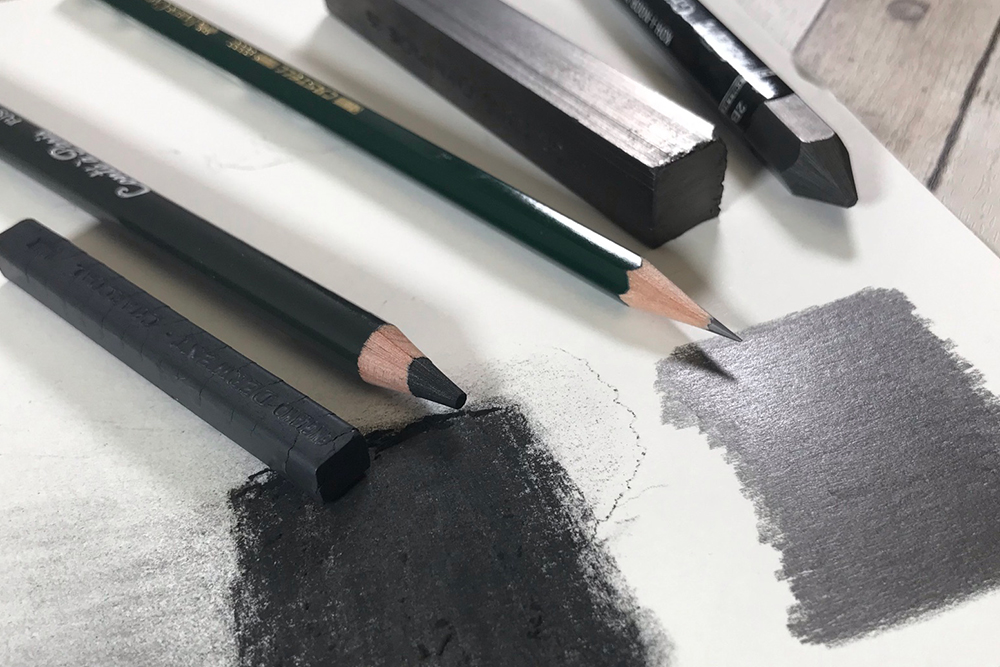
Although both Graphite and Charcoal are have a carbon base, they do have quite distinct differences. One of their most noticeable differences is their finish. While charcoal gives a rich, matte black finish, graphite will always remain slightly reflective and metallic. Their texture varies dramatically, depending on the type of tool you are using. Typically charcoal is much more dusty, crumbly and scratchy in some cases. The application of graphite is a lot smoother – a quality which makes it more appealing to beginners.
What is Graphite?
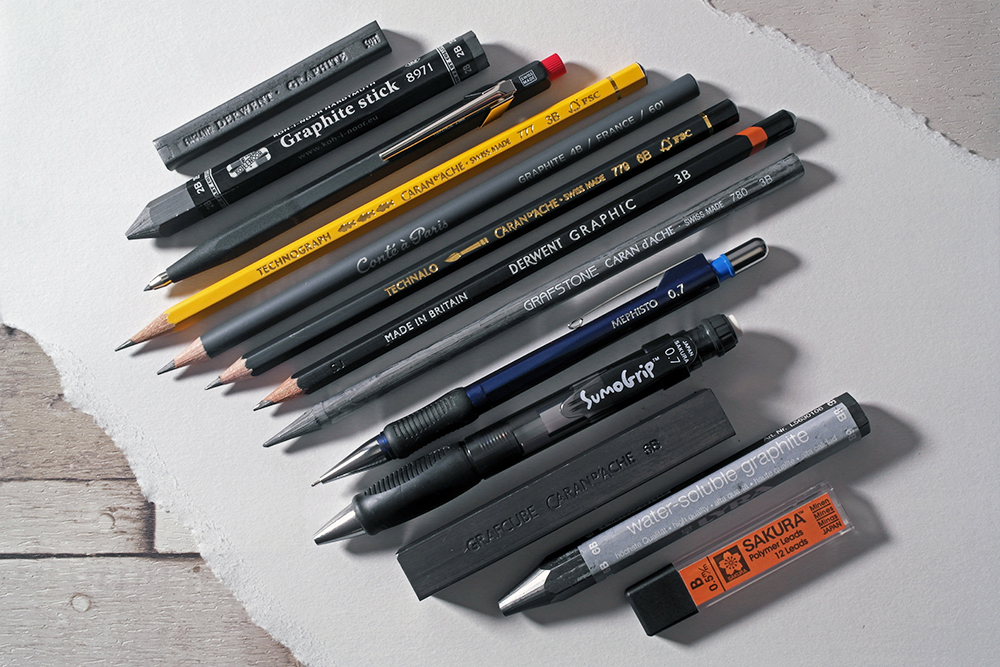
Chemical Structure
Graphite is an allotrope (different structural form) of the element carbon. Although both Graphite and Charcoal are carbon based, the atomic structure of each varies quite dramatically. In graphite, carbon has a uniform arrangement, in distinct layers. Between these layers are very weak chemical bonds. As you draw, these weak bonds break allowing each layer to effortlessly leave the main graphite crystal. This property is how pencils glide so easily over your paper. They leave marks from tiny shards of graphite sheared from the main crystal.
How do you make Graphite?
While graphite is naturally occurring, it can also be produced synthetically. In general it remains relatively unchanged from when it was first discovered. The worlds first graphite ‘pencils’ were essentially raw chunks of graphite from the earth. At this point its main use was to mark sheep. An increase in demand for graphite saw natural reserves deplete. Alterations in manufacturing methods gave us the tool we know as a graphite pencil today. Pencil makers began to use a blend of clay, waxes and graphite powder in order to manufacture pencils on an industrial scale. Today, we make synthetic graphite by heating carbon containing substances to very high temperatures. In this heat, carbon atoms rearrange themselves into the aforementioned uniform layers. This method of production creates a synthetic material with much higher purity than natural graphite.
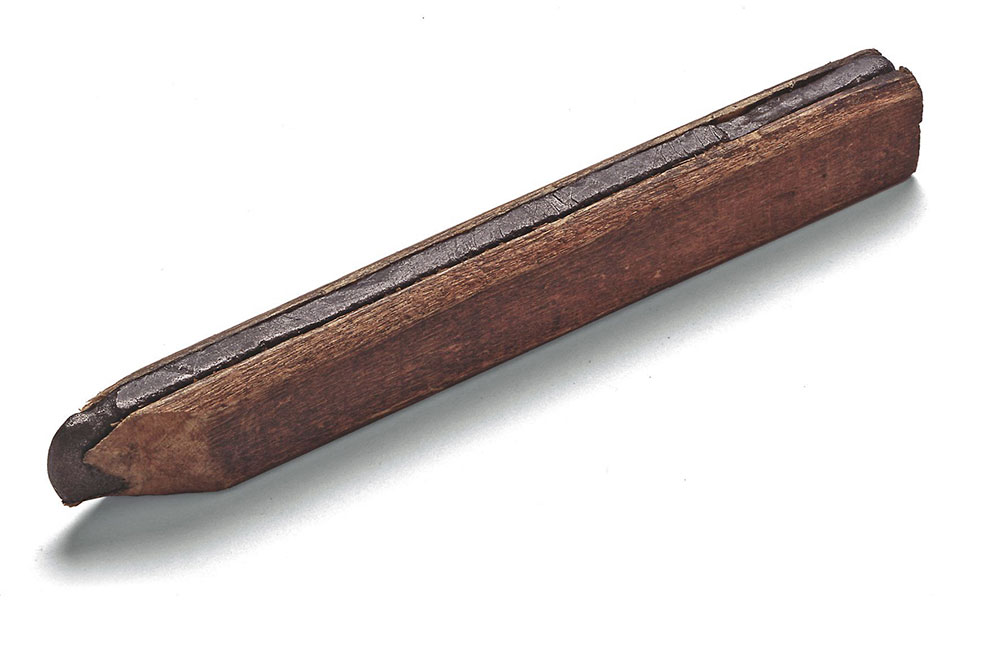
Properties of Graphite
Graphite has a slightly shiny, almost metallic sheen on paper and card. As you build up layers, this shine becomes more noticeable. When comparing Charcoal and Graphite side by side, you’ll notice that graphite is less black and more grey than charcoal. If you work with a variety of grades of pencil you can achieve a broad range of grey shades. The hardest pencils (H grades) being the palest, and softer pencils (B grades) being darker. You can find more about pencil grading system on our blog. Create richer greys and more contrast between light and dark by layering and using a broad selection of pencil grades. Graphite is suitable for use on most sketching papers. It has better adherence than charcoal (which is more dusty) so you will find you need to use little, if any fixative.
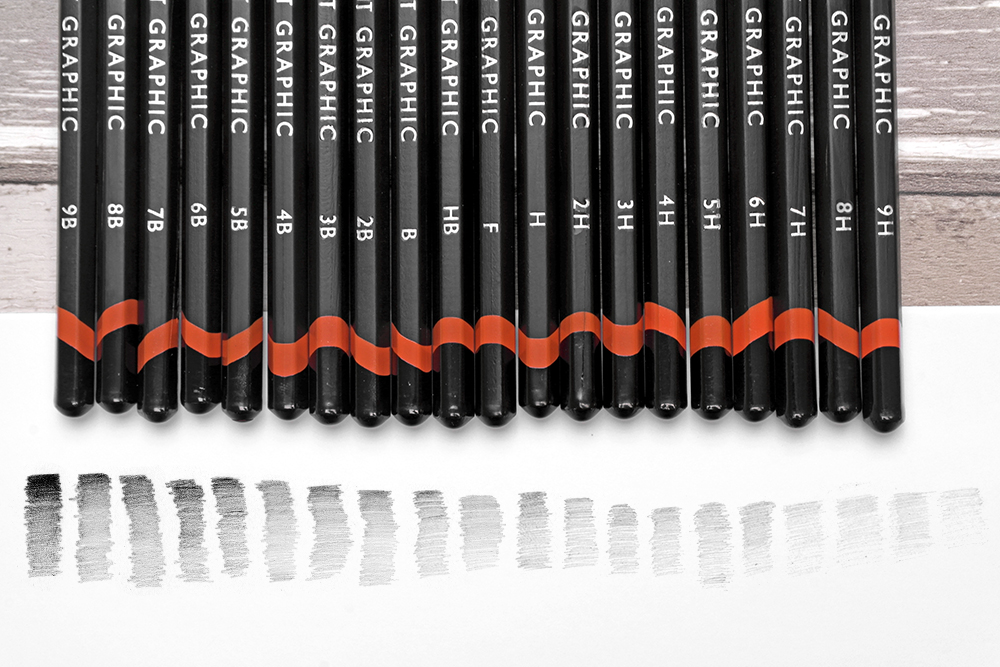
A variety of graphite tools are available – each bringing their own unique working properties to your art.
Graphite Pencils
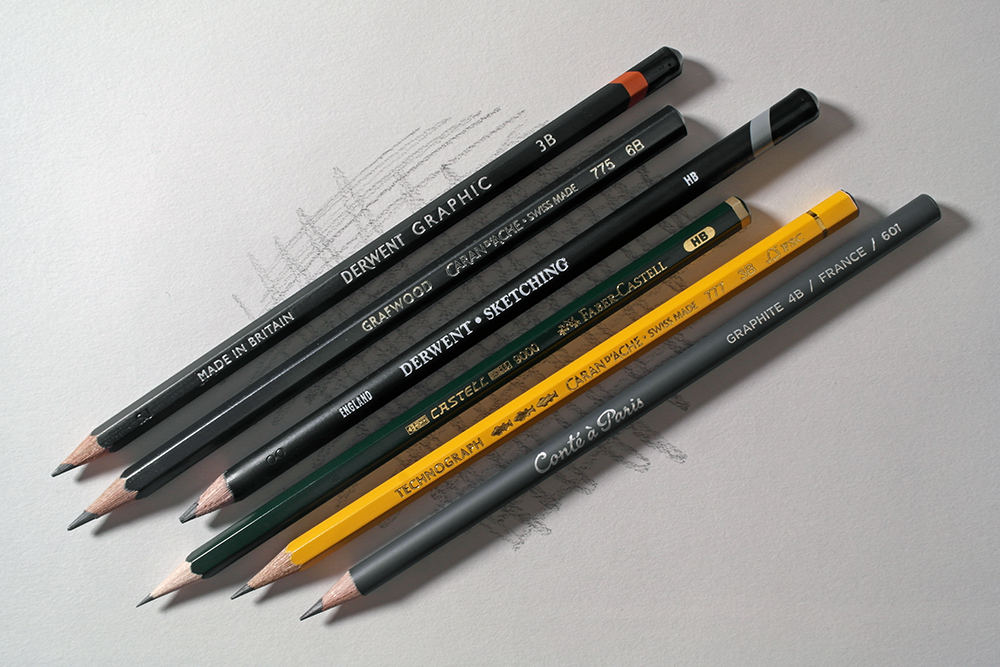
Graphite Pencils are the most popular drawing and sketching tool. They have a wooden barrel which holds the graphite strip. This makes the graphite easy to control, sharpen and means you’re less likely to get messy hands. There are many ranges of graphite pencil available, with most offering a considerable range of grades. You can buy them both individually and in sets – sets are great for beginners, while individual pencils allow you to replace your favourites and tailor your collection to your specific needs.
You can find out more about Graphite Pencils in our Choosing the Right Graphite Sketching & Drawing Pencil article.
Tinted Graphite
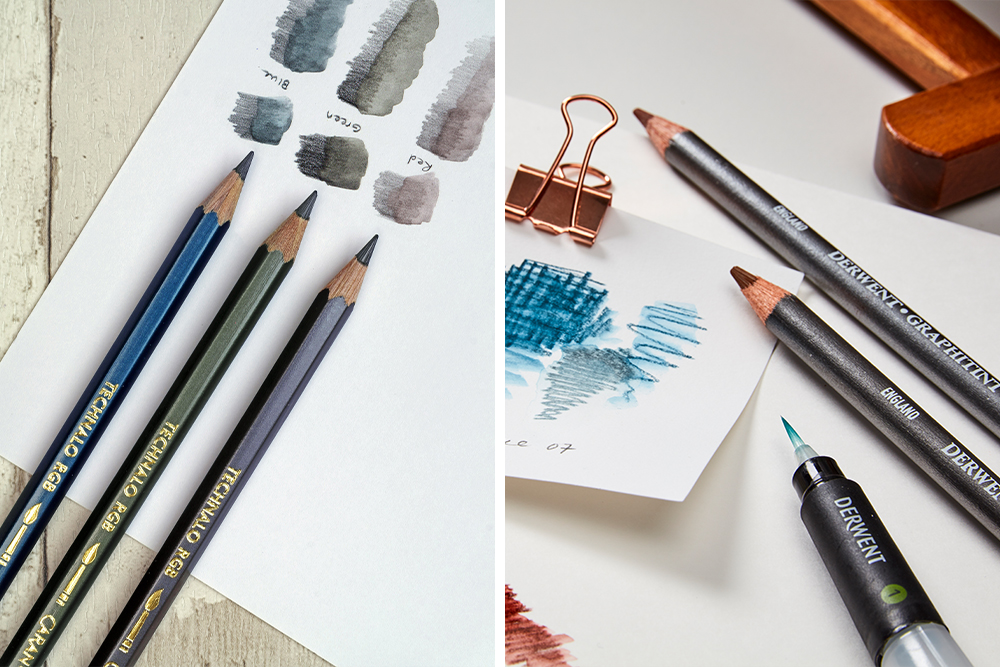
Standard traditional graphite is by far the most common choice for most artists. Coloured graphite pencils are also available, and allow you to add a hint of colour to your sketches. Manufacturers make these pencils from a blend of graphite powder as well as small amounts of pigment. Both the Derwent Graphitint and Caran d’Ache Technalo RGB are examples of tinted graphite. Typically these pencils create subtle colour that retains the reflective quality of graphite.
Water Soluble Graphite
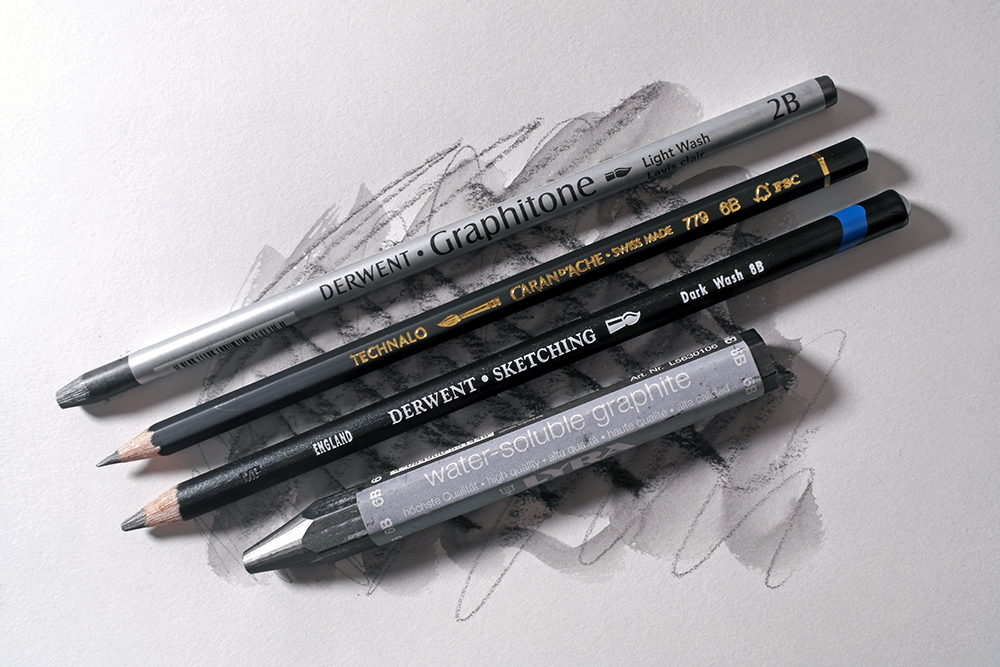
Graphite is blendable with water to some extent, but pencil manufacturers make fully water-soluble versions that use a water-soluble binder. You can apply this special graphite as you would traditional graphite, but with the addition of water you’ll see your lines transform into rich washes. Water-soluble graphite is available in a traditional wooden pencil casing (like Derwent Water-Soluble Sketching Pencils and Caran d’Ache Technalo Pencils) or a woodless graphite stick (Derwent Graphitone and Lyra Graphite Water Soluble Crayons).
Woodless Graphite Pencils & Blocks
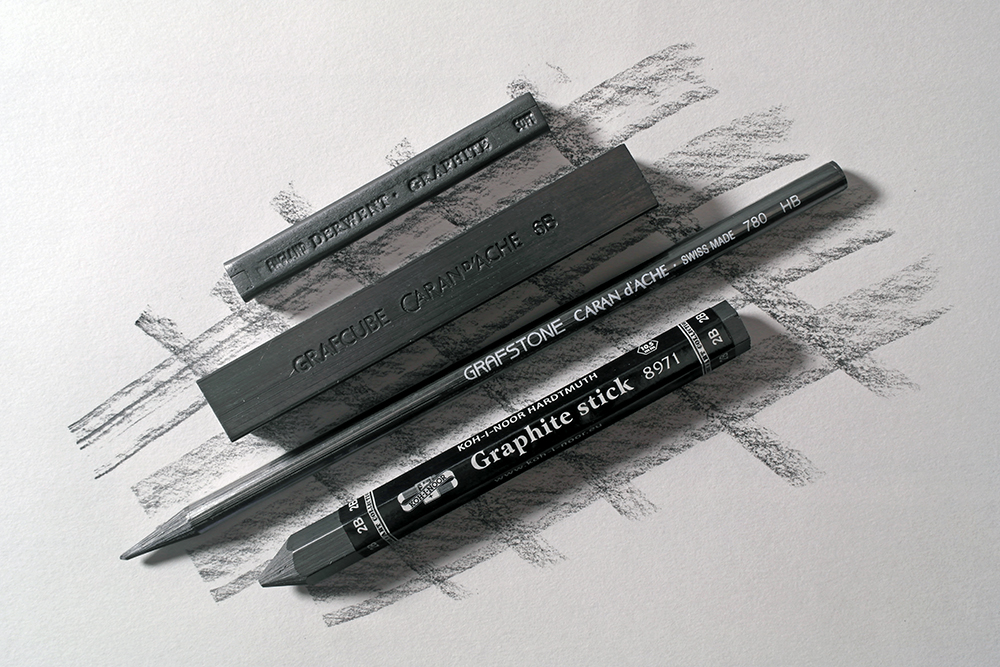
Woodless Graphite Pencils and Graphite Blocks are essentially blocks of graphite without the wooden casing of a traditional pencil. Some of these have pencil-like shape (like the Caran d’Ache Grafstone and Koh-I-Noor Progresso) while others come in a pastel-like block (Derwent Natural Graphite and Caran d’Ache Grafcube). Typically woodless pencils have a paper band or coating on the sides of the pencil to keep your hands clean. You can tear this away manually or with a sharpener as you use the pencil.
This type of tool doesn’t limit you to a thin strip of graphite with which to make your marks. You can use the whole tip of a woodless pencil, and every side and edge of a block. This is great if you’re looking to create bold marks or strokes of graphite. Blocks and woodless pencils can even be broken down into irregular chunks that are great for experimental mark making.
Mechanical & Clutch Pencils
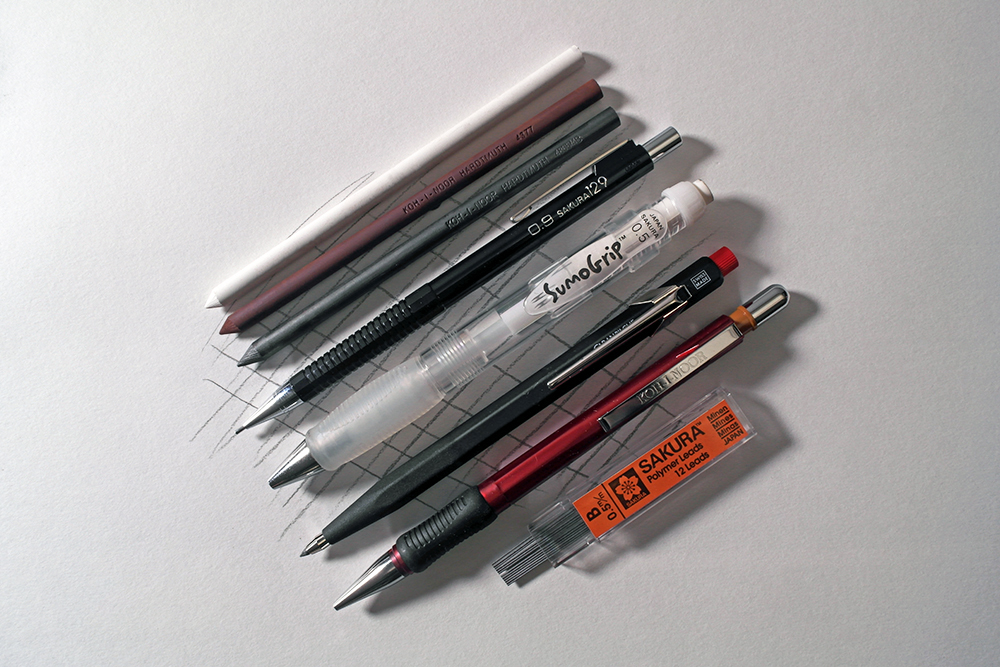
Mechanical and Clutch Pencils are plastic and/or metal barrels into which you insert a graphite lead. You feed through the leads to the tip of the pencil by repeatedly pressing the button at the top of the barrel.
Mechanical pencil leads are very fine and have a uniform width so that they move easily through the tip of the pencil. The widest lead thickness that we stock is 0.9mm (in the Sakura XS Series) – even these are very thin and delicate. The fineness of the leads in Mechanical pencil makes them a popular choice for artists who make technical drawings. They don’t require sharpening either – so are handy if you’re looking for a drawing tool to take outdoors. Some brands also have erasers inbuilt into the metal cap at the top. You might also see Mechanical Pencils referred to as propelling pencils.
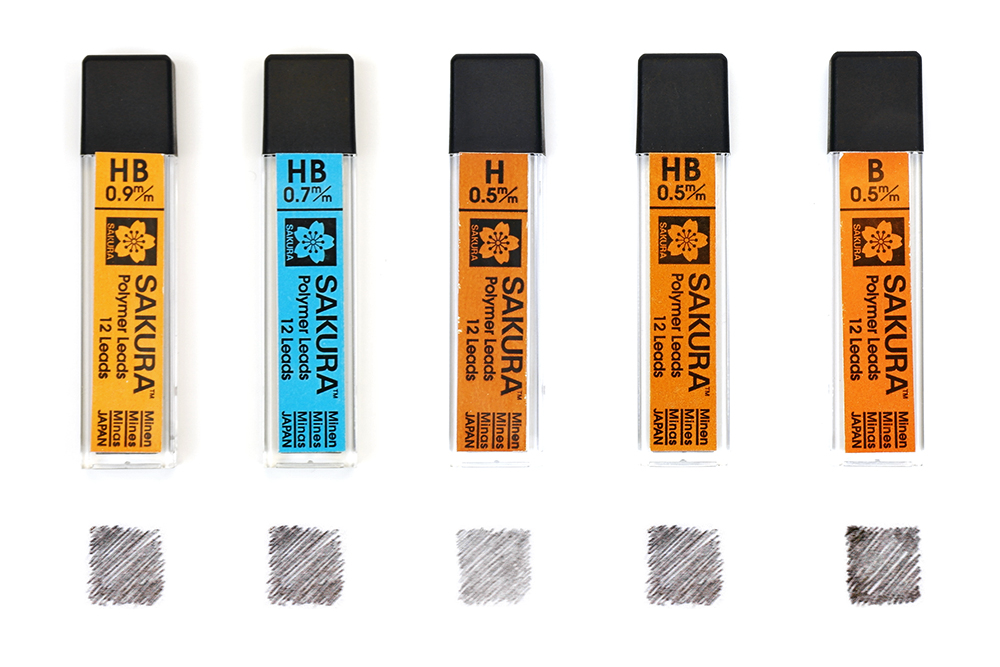
Clutch Pencils work similarly to Mechanical Pencils, but their leads are much thicker. When you press the top of a clutch pencil it releases the lead so it is free to move inside the barrel. It does not gradually move the lead through the barrel like in a Mechanical pencil. As their leads are wider they do require sharpening. This can either by done using our M&R Clutch Pencil Lead Pointer or a sandpaper block. There are also tinted refill leads available for some brands.
What is Charcoal?
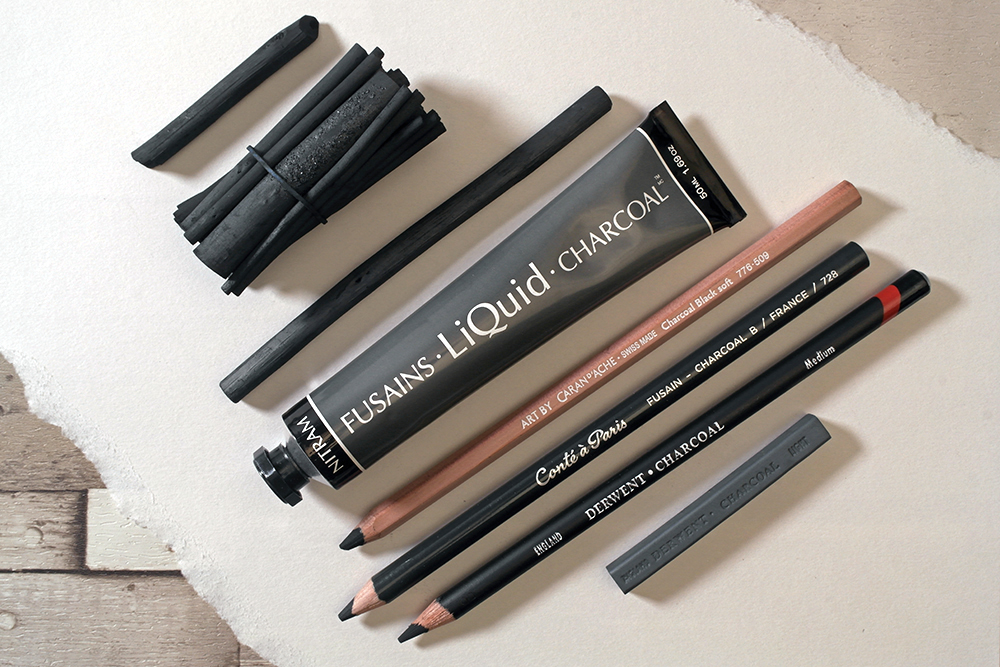
Chemical Structure
Charcoal has a considerably different chemical structure than Graphite, despite both being made from carbon. The make-up of charcoal is much more non-uniform and irregular. The structure folds in on itself, which gives charcoal its soft, crumbly texture. This structure not also makes charcoal a fantastic drawing tool, but also makes it suitable for other applications like filtering.
How do you make Charcoal?
The use of charcoal stretches back the the very beginning of human history. Traces of charcoal can be found in some of the world’s oldest cave paintings. Over time changes were made to refine the material, leading it to become a popular drawing tool for artists. It was particularly popular during the Renaissance with artists like Rembrandt and Degas.
Artists charcoal was first made by peeling thin willow twigs and burning them in the absence of oxygen. This incomplete combustion transforms the twigs into the soft, crumbly sticks we recognise as willow charcoal. In the 20th century, manufacturers began producing compressed charcoal – a harder, darker alternative to natural charcoal.
Properties of Charcoal
Charcoal has a rich matte, non-reflective finish. It’s texture is quite soft and crumbly. Because of this, its marks are less hard and precise compared to Graphite. Charcoal is great for making anything from the richest blacks through to pale, wispy greys. Your marks will typically be very dark at the pressure point. As you ease the pressure your marks will become lighter and more powdery. These properties make it great for loose, expressive drawings. Because of charcoal’s irregular texture it can feel like it snags or scratches on paper. It’s texture is also quite dusty – so you are best using it on paper with some tooth. It makes beautifully textured marks on really rough paper. You are best protecting your drawings with fixative as charcoal doesn’t adhere to paper the same way as graphite.
There is more choice in charcoal drawing tools than artists’ have ever had before. Check below to see how to use each one.
Natural Charcoal
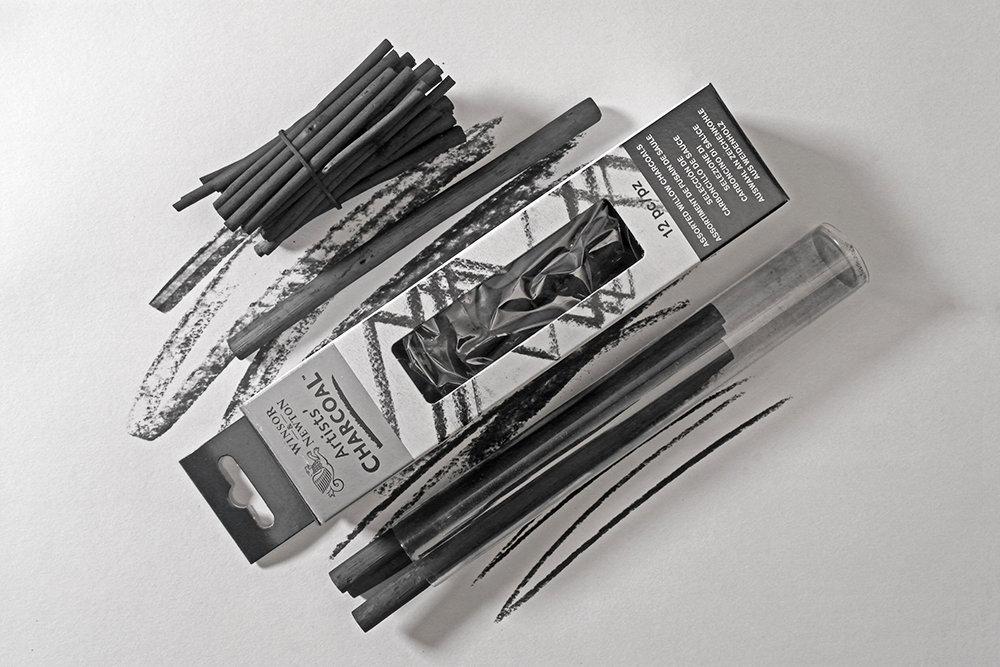
Natural charcoal (Like Winsor & Newton Willow and Caran d’Ache Natural Charcoal) is typically made from Willow or Vine. Because it is a natural product, you’ll notice a lot of variations in the shapes and sizes available. Some sticks may still look very twig like – it’s very common to find knots and kinks in a natural charcoal stick! The natural differences between each stick does mean that they perform slightly differently. Be sure to test them on a scrap piece of paper if you’re looking for a certain result. This type of charcoal contains no binder, is the least black and most dusty. It also has a brittle texture.
Compressed Charcoal
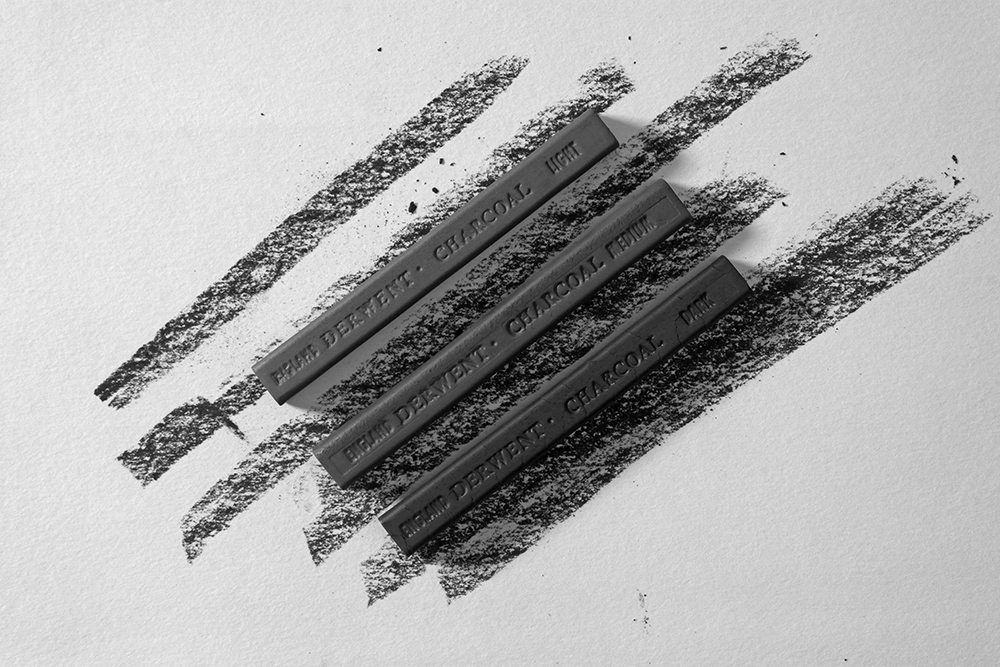
Compressed Charcoal sticks come in a pastel-like block – with either a round or square profile. This type of charcoal is made with a mixture of powdered charcoal and a binder, which are compressed. Manufacturers alter the hardness of charcoal by varying the amount of binder in the mix – similarly to graphite pencils. Compressed charcoal is much more durable than natural charcoal – less likely to snap and produces less dust. It is also much harder, darker and more difficult to erase. It gives a more uniform, predictable result.
Charcoal Pencils
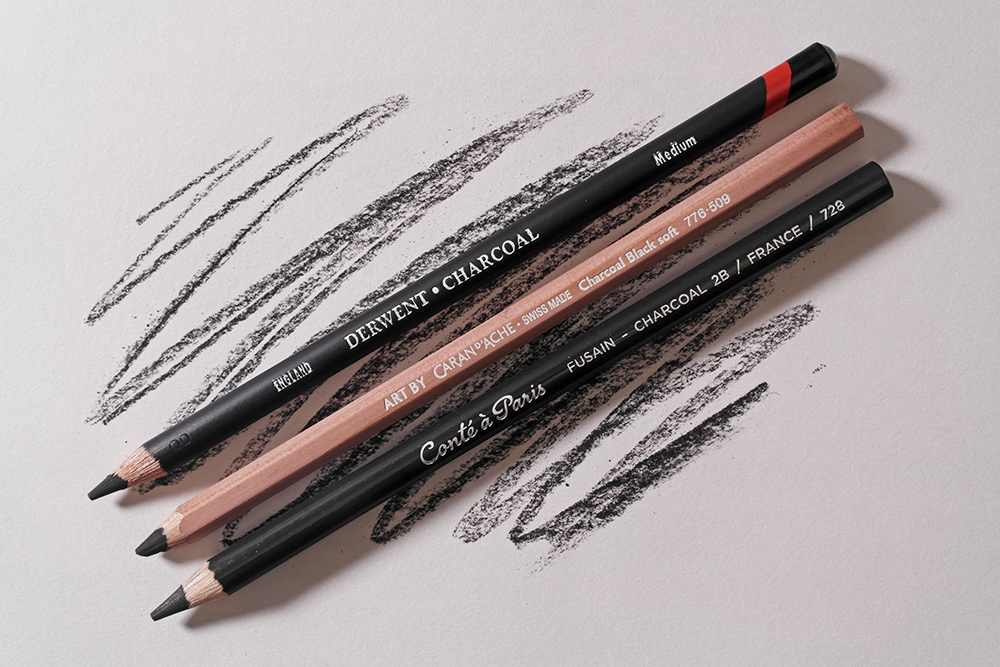
Charcoal Pencils offer all the benefits of compressed charcoal, but with the convenience of a wooden case. Working in much the same way as a traditional pencil, charcoal pencils allow you to work with precision – without messy hands! Their wooden case means they are less likely to break, and they can be easily sharpened to a fine point. They’re fantastic for artists looking to try out charcoal, but who want some of the familiarity of a pencil.
Tinted Charcoal
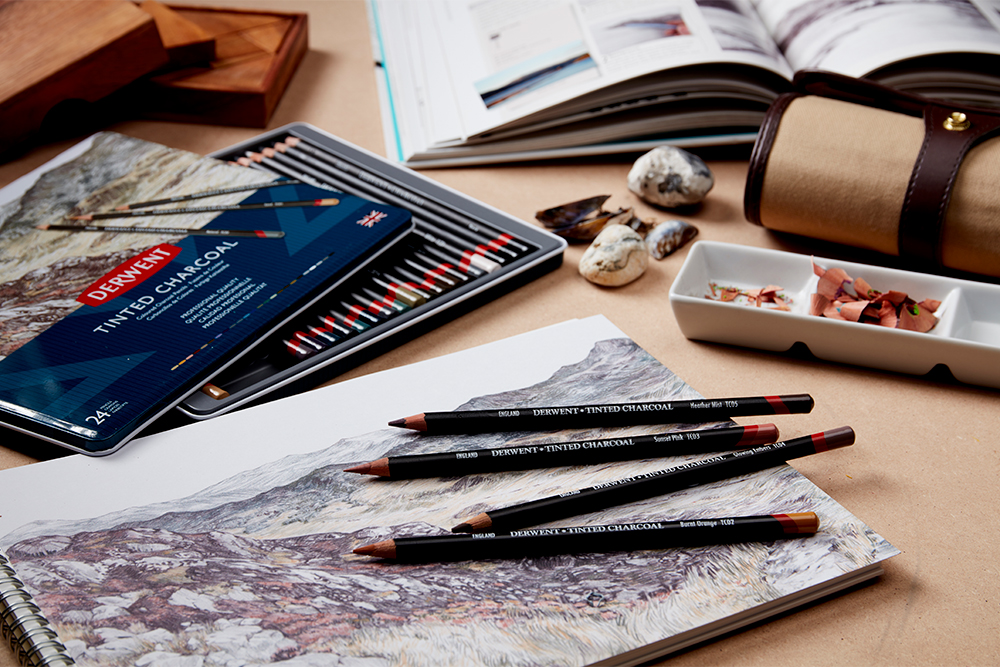
Tinted Charcoal is made in the same way as compressed charcoal, but with a little pigment added into the powdered charcoal. Typically the colour of tinted charcoal is quite subtle and earthy. Derwent Tinted Charcoal is sold in pencil format – allowing you to enjoy the natural properties of charcoal while adding a subtle hint of colour to your work. Tinted charcoal blocks are also available in a set in the Derwent Tinted Charcoal XL Blocks Tin.
Nitram Fine Art Charcoal
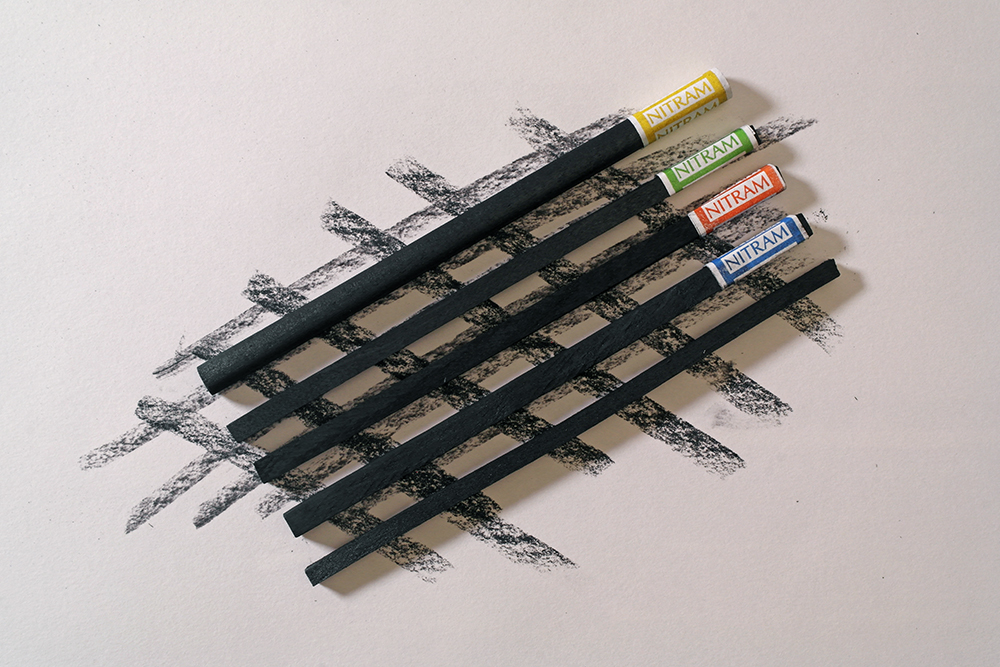
Nitram Fine Art Charcoal is a special kind of charcoal with exceptional durability and low dusting. It has more in common with natural charcoal than compressed charcoal. Manufacturers make Nitram charcoal using a unique process that preserves the cell structure of the wood. This results in its resistance to breakage. Because it is less dusty it is ideal for artists who are sensitive to the dust that regular charcoal generates. This property also makes it ideal for use with wet media. Nitram applies smoothly and can be used with putty erasers. Its ability to lift makes it perfect for subtractive drawing techniques.
Nitram charcoal is available in a variety of sticks in various shapes and sizes. There are also stick holders available.
Liquid Charcoal
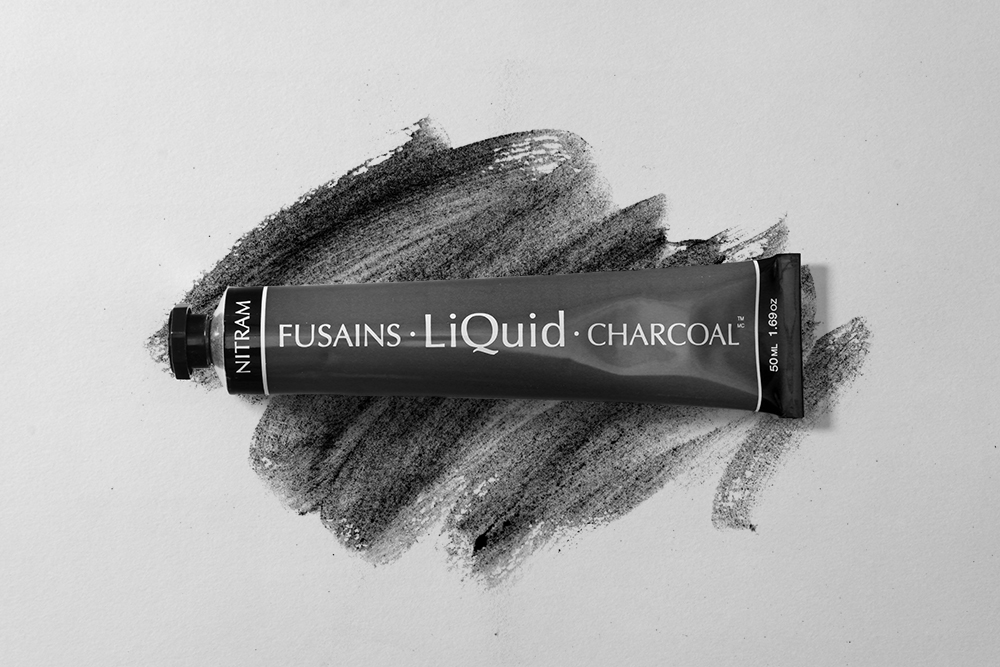
Nitram Liquid Charcoal is an innovative product combining powdered charcoal with gum Arabic. This results in a paint with a thick texture, that you can use straight from the tube or diluted with water. Without water, its texture is similar to an oil paint. This thickness can create some great textural effects, especially when applied with a painting knife. With water, you can achieve soft, granulated washes that have a watercolour-like quality. It is resoluble, so once dry you can rework it with water. You can also create tinted washes by mixing it with watercolour.
Powdered Charcoal
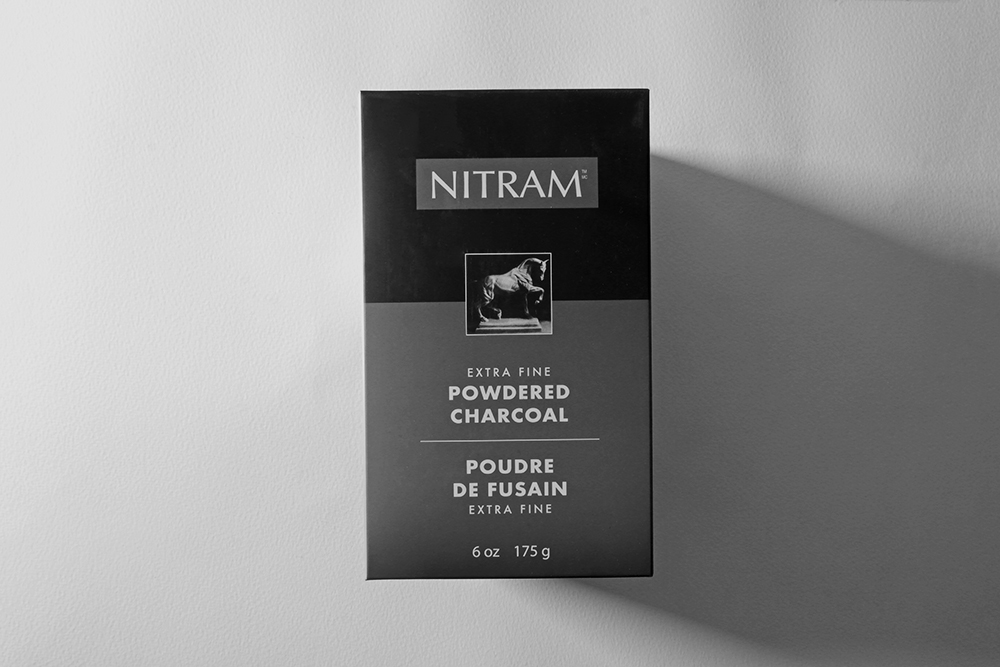
Nitram Powdered Charcoal is an extra finely milled powder that you can apply with a brush, paper stump or other blending tool. It applies smoothly and is great if you’re looking to cover a large area. Changing the types of brushes you use to apply the charcoal will affect how light or dark your application is. It is packaged in a sturdy aluminium tin which can be firmly sealed to prevent messy leaks. The tin also has a recessed reservoir which allows to you to control the amount of charcoal you tip from the tin. Palette knives can also be used to remove and apply the powder.
Choosing Between Graphite and Charcoal
Charcoal and Graphite both bring different properties to your work. Beginners may find it useful to weigh up the pros and cons of using both drawing materials, before settling on one to start with.
Charcoal
Pros
- Much easier to create broad, expressive marks, so may be more suitable for beginners working on a large scale.
- It’s matt finish makes it much easier to layer and create the darkest blacks without any reflectivity.
- Because it is less precise it encourages spontaneity, which makes it easier to build up drawings quickly.
- Great for capturing quick composition ideas, or for use in Life Drawing classes when you need to be able to record things quickly.
Cons
- It is much messier than Graphite to work with. Even if you use Charcoal pencils you will still find that they generate more dust than graphite.
- Can be more difficult to transport charcoal as it is more fragile and messy.
- It’s easy to disturb the dust charcoal generates and accidentally smudge or dirty your work. More fixative is required to protect your final work.
Graphite
Pros
- Graphite Pencils are perhaps the first drawing tools you’ll be introduced to as a beginner. They’re simple and easy to use, and most people are familiar with them outside an art setting.
- Graphite isn’t as messy as charcoal, so it is less likely to smudge and much easier to protect (requiring very little, if any, fixative). This makes it more simple to work with for new artists.
- Graphite is more durable and easier to transport than Charcoal, so would be easy to take out on drawing trips and classes.
- If you’re working on a small scale then the precision tip of a pencil is more suitable for rendering small details.
Cons
- Artists working on large scale drawings might find traditional pencils too small – it takes longer to cover an area with a pencil than it does a charcoal stick. For example, if you’re attending life drawing classes, you might find the precise nib of a pencil too restrictive.
- If you’re building up layers of graphite they can quickly become reflective and shiny which can be unsightly in your finished piece.
- The reflective surface can also be problematic when you come to photograph your work.
Hints & Tips for working in Graphite and Charcoal
Working with graphite and charcoal can be a really rewarding experience. Here are some hints and tips to help you get the most out of these mediums:
- As you build up your confidence using graphite and charcoal separately, you could move onto combining them both in a drawing. Using both materials alongside each other can create an interesting contrast between matte and reflective areas.
- If you are working solely with graphite, try to use a broad range of grades of pencils to make the most of every shade. If you’re making precision marks then stick with pencils, but for bolder strokes try out graphite blocks. Using a selection of graphite supplies will bring more versatility to your work. To learn more about our Graphite Pencil range check out our Choosing the Right Graphite Sketching & Drawing Pencil blog.
- If you are working solely with charcoal, try out as many types as possible to see what types of marks you can achieve with them. Using combinations of natural and compressed charcoals will allow you to explore a broader range of shades.
- If you’re working with charcoal you may come across tinted ‘White Charcoal’ pencils. Technically these aren’t ‘true’ charcoal as they are made up of white pigment and binder, but they can be used alongside charcoal in your artwork.
- When you’re exploring the types of charcoal and pencil available you may come across Carbon Pencils. Carbon pencils are derived from traditional charcoal, but are made with a different form of carbon. This variation means they are stronger and much less dusty. They also have a much more even texture and are smoother to apply. Like Graphite pencils they are typically available in a range of grades.

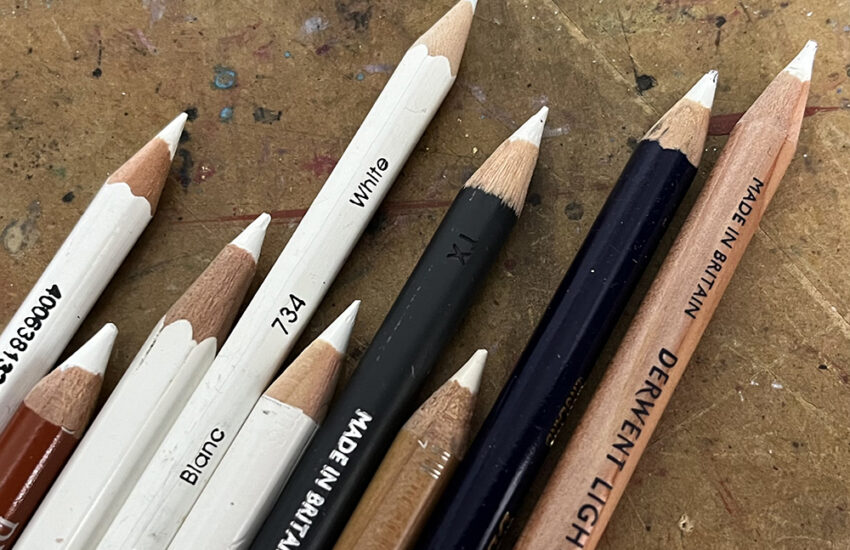
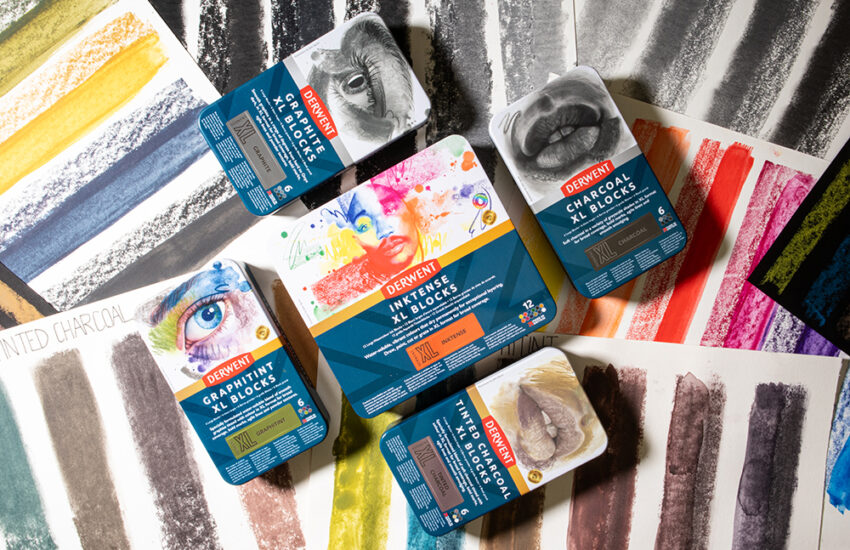
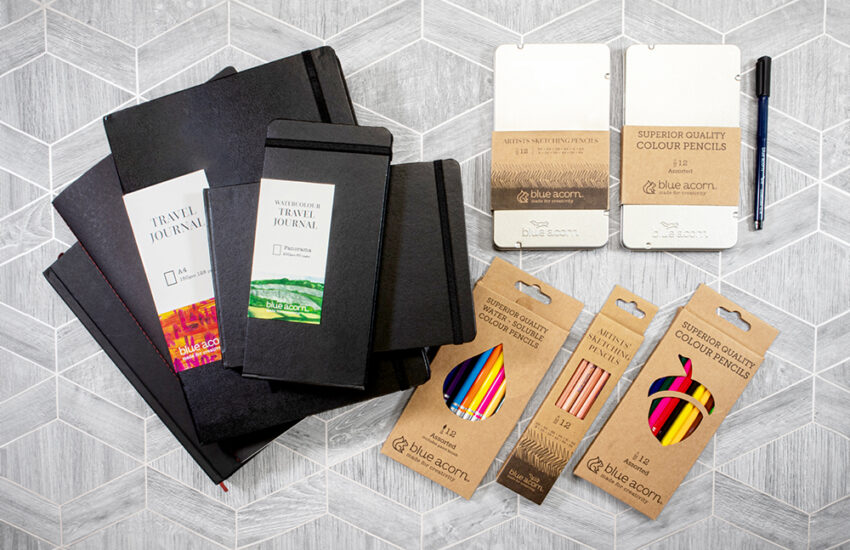
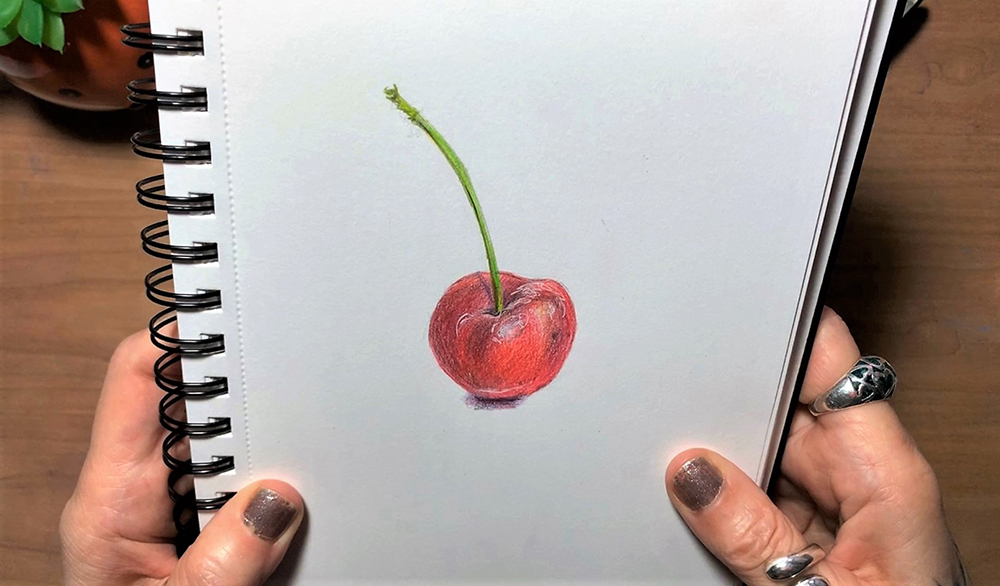


I find all the advice and info on your site really interesting and helpful. I’d no idea there were so many variations within the charcoal/graphite range and, as a keen user of both, look forward to experimenting! Thanks.
whats the differences between charcoal pencils to carbon/carbon extra dark pencils?
also there are the graphite matt pencils like the “STAEDTLER mars lumograph black” (come in HB,2B,4B,6B,7B,8B grades) and New (2021) Faber Castell Pitt Matte Pencils (come in HB2B 4B 6B 8B 10B 12B 14B), how they compared to graphite/charcoal?
Hi Ronny. Thanks for your comment. Carbon pencils are similar to charcoal, and combine the best features of graphite and charcoal. They’re much smoother, stronger and are made with a purer form of carbon. They produce deep, rich black without the scratchiness or dustiness of charcoal. Unfortunately I can’t comment on the STAEDTLER mars lumograph black pencils as we don’t stock them. The Faber-Castell PITT Matt Graphite Pencils perform like a standard graphite pencil but without the reflective glare you’d usually expect from the medium. They also produce much less dust have have greater point strength compared to charcoal.
K B s Blog product description and advice is always helpful and informative..
even after many years of artistic practice it’s great to have clear and simple information
and this in turn encourages creative experiment.